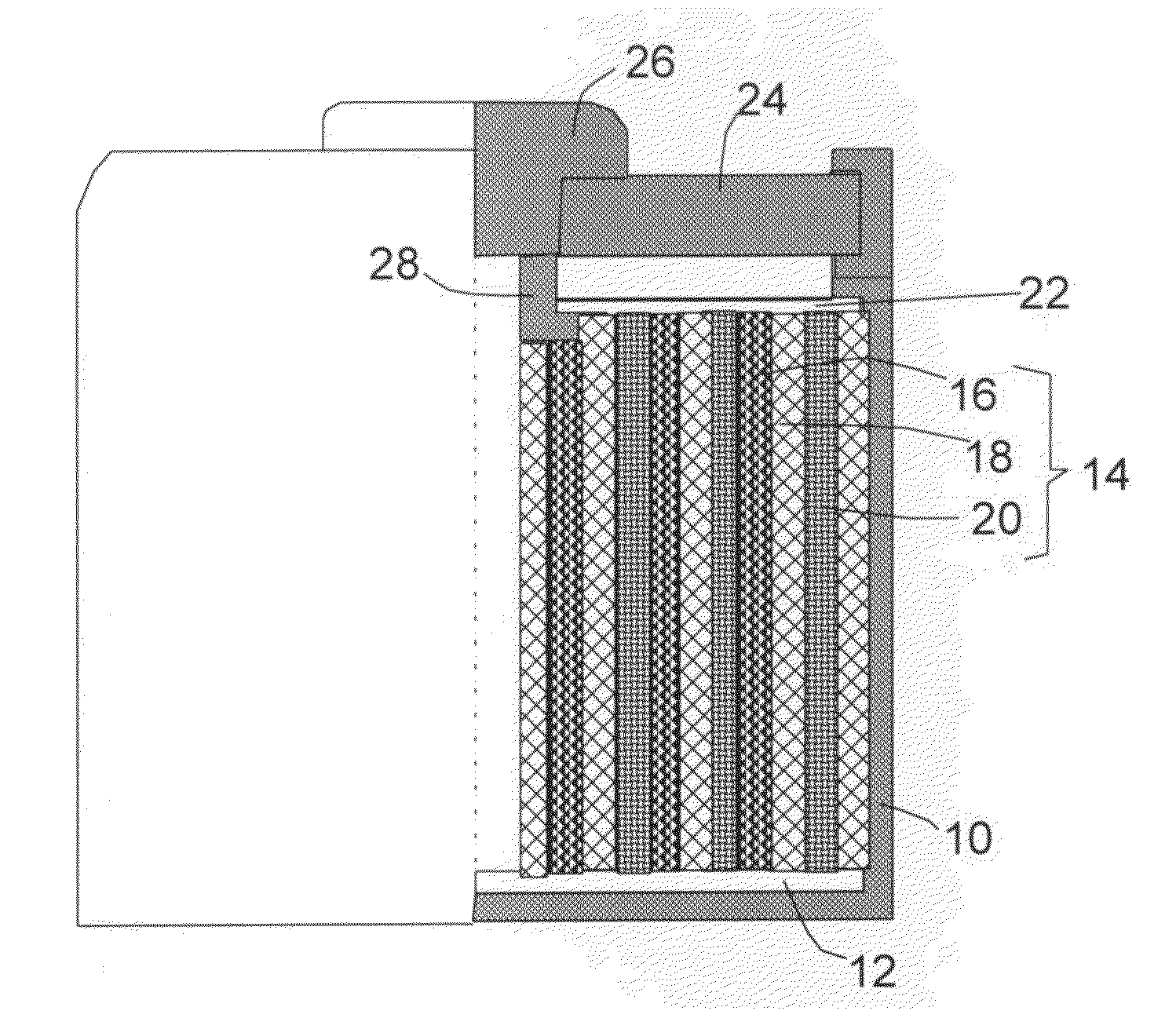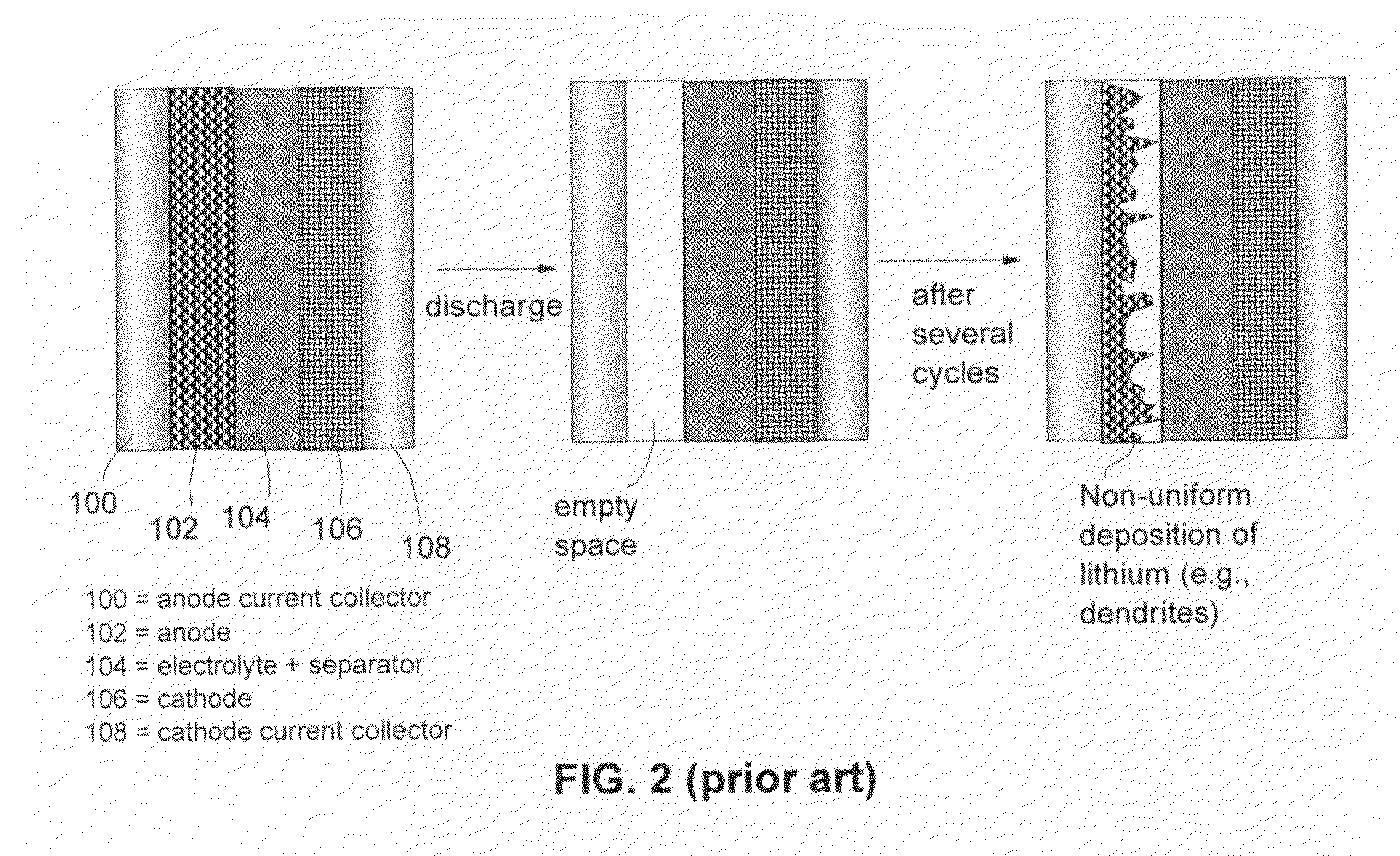Anode compositions for lithium secondary batteries
a secondary battery and composition technology, applied in secondary cells, fuel and other directions, can solve the problems of dendrite formation, high specific capacity, and undesirable electroplating of lithium onto the fiber surface, and achieve excellent reversible capacity and long cycle life. , the effect of high specific capacity
- Summary
- Abstract
- Description
- Claims
- Application Information
AI Technical Summary
Benefits of technology
Problems solved by technology
Method used
Image
Examples
example 1
Conductive Web of Filaments from Electro-Spun PAA Fibrils
[0153]Poly (amic acid) (PAA) precursors for spinning were prepared by copolymerizing of pyromellitic dianhydride (Aldrich) and 4,4′-oxydianiline (Aldrich) in a mixed solvent of tetrahydrofurane / methanol (THF / MeOH, 8 / 2 by weight). The PAA solution was spun into fiber web using an electrostatic spinning apparatus schematically shown in FIG. 4. The apparatus consisted of a 15 kV d.c. power supply equipped with the positively charged capillary from which the polymer solution was extruded, and a negatively charged drum for collecting the fibers. Solvent removal and imidization from PAA were performed concurrently by stepwise heat treatments under air flow at 40° C. for 12 h, 100° C. for 1 h, 250° C. for 2 h, and 350° C. for 1 h. The thermally cured polyimide (PI) web samples were carbonized at 1,000° C. to obtain Sample c-PI-0 with an average fibril diameter of 67 nm. Such a web can be used to accommodate lithium coatings (during r...
example 2
Conductive Web of Filaments from Electro-spun PAN Fibrils and NGP-containing PAN Fibrils
[0154]Suspension solutions were obtained by first preparing two solutions (A=solvent+NGPs and B=solvent+polymer) and then mixing the two solutions together to obtain the suspension solution. In the case of NGP-PAN fibril, the solvent used was N,N,-dimethyl formamide (DMF). For the preparation of Suspension A, the NGPs were added to a solvent and the resulting suspensions were sonicated to promote dispersion of separate NGPs in the solvent with a sonication time of 20 minutes. Suspension solution B was obtained by dissolving the polymer in the solvent with the assistance of heat (80° C. for DMF+PAN) and stirring action using a magnetic stirrer typically for 90 and 30 minutes, respectively. Suspensions A and B were then mixed together and further sonicated for 20 minutes to help maintain a good dispersion of NGPs in the polymer-solvent solution. An electrostatic potential of 10 kV was applied over ...
example 3
Preparation of NGP-Based Webs (Aggregates of NGPs and NGPs+CNFs)
[0157]Continuous graphite fiber yarns (Magnamite AS-4 from Hercules) were heated at 800° C. in a nitrogen atmosphere for 5 hours to remove the surface sizing. The yarns were cut into segments of 5 mm long and then ball-milled for 24 hours. The intercalation chemicals used in the present study, including fuming nitric acid (>90%), sulfuric acid (95-98%), potassium chlorate (98%), and hydrochloric acid (37%), were purchased from Sigma-Aldrich and used as received.
[0158]A reaction flask containing a magnetic stir bar was charged with sulfuric acid (360 mL) and nitric acid (180 mL) and cooled by immersion in an ice bath. The acid mixture was stirred and allowed to cool for 15 min, and graphite fibers (20 g) were added under vigorous stirring to avoid agglomeration. After the graphite fiber segments were well dispersed, potassium chlorate (110 g) was added slowly over 15 min to avoid sudden increases in temperature. The reac...
PUM
 Login to View More
Login to View More Abstract
Description
Claims
Application Information
 Login to View More
Login to View More - R&D
- Intellectual Property
- Life Sciences
- Materials
- Tech Scout
- Unparalleled Data Quality
- Higher Quality Content
- 60% Fewer Hallucinations
Browse by: Latest US Patents, China's latest patents, Technical Efficacy Thesaurus, Application Domain, Technology Topic, Popular Technical Reports.
© 2025 PatSnap. All rights reserved.Legal|Privacy policy|Modern Slavery Act Transparency Statement|Sitemap|About US| Contact US: help@patsnap.com



